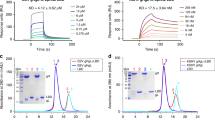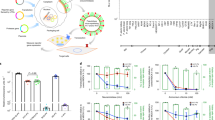Abstract
The onset of leukaemia caused by type C retroviruses (MLV) in mice is accelerated by the emergence of recombinant polytropic or mink cell focus–forming (MCF) viruses1,2,3,4. Susceptibility to infection by polytropic/MCF and also by closely related xenotropic MLV has been mapped to Rmc1 on mouse chromosome 1 (refs 5, 6 and 7). To identify this gene, we introduced an expression cDNA library prepared from mouse NIH3T3 fibroblasts into nonpermissive hamster cells and screened these cells for acquired susceptibility to MCF viruses encoding β–galactosidase and G418 resistance. From hamster cell clones identified in the screen, we recovered a mouse cDNA that maps to Rmc1 and confers MCF MLV infection when expressed in nonpermissive cell lines. It encodes a membrane protein related to Syg1p (suppressor of yeast Gα deletion; ref. 8). The receptor–binding domain of the MCF MLV envelope protein binds specifically to Xenopus laevis oocytes that express mouse Syg1, suggesting it functions as a receptor that mediates virus entry. We also obtained the cDNA encoding human SYG1. When expressed in hamster cells, it establishes infectivity by MCF MLV as well as xenotropic MLV, which do not infect laboratory mice.
This is a preview of subscription content, access via your institution
Access options
Subscribe to this journal
Receive 12 print issues and online access
$209.00 per year
only $17.42 per issue
Buy this article
- Purchase on Springer Link
- Instant access to full article PDF
Prices may be subject to local taxes which are calculated during checkout




Similar content being viewed by others
References
Stoye, J.P., Moroni, C. & Coffin, J.M. Virological events leading to spontaneous AKR thymomas. J. Virol. 65, 1273–1285 (1991).
Fan, H. Leukemogenesis by Moloney murine leukemia virus: a multistep process. Trends Microbiol. 5, 74–82 (1997 ).
Ruscetti, S., Davis, L., Field, J. & Oliff, A. Friend murine leukemia virus–induced leukemia is associated with the formation of mink cell focus–inducing viruses and is blocked in mice expressing endogenous mink cell focus–inducing xenotropic viral envelope genes. J. Exp. Med. 154, 907–920 (1981).
Herr, W. & Gilbert, W. Free and integrated recombinant murine leukemia virus DNAs appear in preleukemic thymuses of AKR/J mice. J. Virol. 50, 155–162 ( 1984).
Hunter, K., Housman, D. & Hopkins, N. Isolation and characterization of irradiation fusion hybrids from mouse chromosome 1 for mapping Rmc1, a gene encoding a cellular receptor for MCF class murine retroviruses. Somat. Cell Mol. Genet. 17, 169–183 (1991).
Kozak, C.A. Genetic mapping of a mouse chromosomal locus required for mink cell focus–forming virus replication. J. Virol. 48, 300– 303 (1983).
Lyu, M. & Kozak, C.A. Genetic basis for resistance to polytropic murine leukemia viruses in the wild mouse species Mus castaneus . J. Virol. 70, 830– 833 (1996).
Spain, B.H., Koo, D., Ramakrishnan, M., Dzudzor, B. & Colicelli, J. Truncated forms of a novel yeast protein suppress the lethality of a G protein α subunit deficiency by interacting with the β subunit. J. Biol. Chem. 270, 25435–25444 (1995).
Kitamura, T. et al. Efficient screening of retroviral cDNA expression libraries. Proc. Natl Acad. Sci. USA 92, 9146– 9150 (1995).
Pear, W.S., Nolan, G.P., Scott, M.L. & Baltimore, D. Production of high–titer helper–free retroviruses by transit transfection. Proc. Natl Acad. Sci. USA 90, 8392– 8396 (1993).
Albritton, L.M., Tseng, L., Scadden, D. & Cunningham, J.M. A putative murine ecotropic retrovirus receptor gene encodes a multiple membrane–spanning protein and confers susceptibility to virus infection. Cell 57, 659–666 (1989).
Loiler, S.A., DiFronzo, N.L. & Holland, C.A. Gene transfer to human cells using retrovirus vectors produced by a new polytropic packaging cell line. J. Virol. 71, 4825–4828 (1997).
Davey, R.A., Hamson, C.A., Healey, J.J. & Cunningham, J.M. In vitro binding of purified murine ecotropic retrovirus envelope surface protein to its receptor, MCAT–1. J. Virol. 71 , 8096–8102 (1997).
Battini, J.L., Heard, J.M. & Danos, O. Receptor choice determinants in the envelope glycoproteins of amphotropic, xenotropic, and polytropic murine leukemia viruses. J. Virol. 66, 1468–1475 (1992).
Ott, D. & Rein, A. Basis for receptor specificity of nonecotropic murine leukemia virus surface glycoprotein gp70SU. J. Virol. 66, 4632–4638 (1992).
Battini, J.L., Danos, O. & Heard, J.M. Receptor–binding domain of murine leukemia virus envelope glycoproteins. J. Virol. 69, 713 –719 (1995).
Chesebro, B. & Wehrly, K. Different murine cell lines manifest unique patterns of interference to superinfection by murine leukemia viruses. Virology 141, 119–129 (1985).
Kozak, C.A. Susceptibility of wild mouse cells to exogenous infection with xenotropic leukemia viruses: control by a single dominant locus on chromosome 1. J. Virol. 55, 690–695 ( 1985).
Adams, R.M. et al. Transduction of primary human hepatocytes with amphotropic and xenotropic retroviral vectors. Proc. Natl Acad. Sci. USA 89, 8981–8985 (1992).
Fass, D. et al. Structure of a murine leukemia virus receptor–binding glycoprotein domain at 2.0 Angstrom resolution. Science 277, 1662–1666 (1997).
Li, J.P. & Baltimore, D. Mechanism of leukemogenesis induced by mink cell focus–forming murine leukemia viruses. J. Virol. 65, 2408–2414 ( 1991).
Flubacher, M.M., Bear, S.E. & Tsichlis, P.N. Replacement of interleukin–2 (IL–2)–generated mitogenic signals by a mink cell focus–forming (MCF) or xenotropic virus–induced IL–9–dependent autocrine loop: implications for MCF virus–induced leukemogenesis. J. Virol. 68, 7709– 7716 (1994).
Kusumi, K., Smith, J.S., Segre, J.A., Koos, D.S. & Lander, E.S. Construction of a large–insert yeast artificial chromosome library of the mouse genome. Mamm. Genome 4, 391–392 (1993).
Hunter, K.W. et al. Rapid and efficient construction of yeast artificial chromosome contigs in the mouse genome utilizing interspersed repetitive sequence PCR (IRS–PCR): generation of a 5 cM, >5 megabase contig on mouse chromosome 1. Mamm. Genome 5, 597– 607 (1994).
Traunecker, A., Schneider, J., Kiefer, H. & Karjalainen, K. Highly efficient neutralization of HIV with recombinant CD4–immunoglobulin molecules. Nature 339, 68– 70 (1989).
Brojatsch, J., Naughton, J., Rolls, M.M., Zingler, K. & Young, J.A.T. CAR1, a TNFR–related protein, is a cellular receptor for cytopathic avian leukosis–sarcoma viruses and mediates apoptosis. Cell 87, 845– 855 (1996).
Acknowledgements
We thank G. Nolan for the Phoenix–Eco cell line; T. Bianca for preparing MCF–BAG virus; E. Sheppa for assistance with the manuscript; and D. Hirsch, C. Rodriquez, R. Davey, H. Tang and A. Barnett for support and advice. This work was supported by the Howard Hughes Medical Institute and NIH grant 2R01CA/AI61246–06.
Author information
Authors and Affiliations
Corresponding author
Rights and permissions
About this article
Cite this article
Yang, YL., Guo, L., Xu, S. et al. Receptors for polytropic and xenotropic mouse leukaemia viruses encoded by a single gene at Rmc1. Nat Genet 21, 216–219 (1999). https://doi.org/10.1038/6005
Received:
Accepted:
Issue Date:
DOI: https://doi.org/10.1038/6005
This article is cited by
-
Xenotropic and polytropic retrovirus receptor 1 (XPR1) promotes progression of tongue squamous cell carcinoma (TSCC) via activation of NF-κB signaling
Journal of Experimental & Clinical Cancer Research (2019)
-
Selective sweeps versus introgression - population genetic dynamics of the murine leukemia virus receptor Xpr1 in wild populations of the house mouse (Mus musculus)
BMC Evolutionary Biology (2015)
-
XPR1: a Gene Linked to Primary Familial Brain Calcification Might Help Explain a Spectrum of Neuropsychiatric Disorders
Journal of Molecular Neuroscience (2015)
-
No association of xenotropic murine leukemia virus-related virus with prostate cancer or chronic fatigue syndrome in Japan
Retrovirology (2011)
-
XMRV: usage of receptors and potential co-receptors
Virology Journal (2011)



